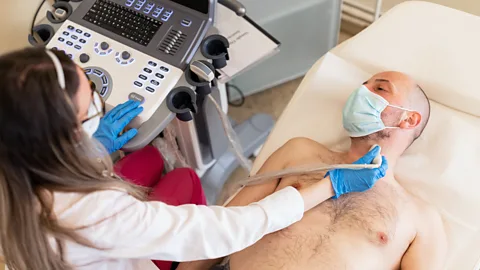
Why Are Thyroid Cancer Cases Increasing Across The World?
- Published By The Statesman For The Statesman Digital
- 48 minutes ago
Thyroid cancer rates are increasing in some parts of the world – and faster than other forms of cancer. Why?
Rates of thyroid cancer are increasing at a faster speed in the US than any other cancer. But what is behind this mysterious epidemic?
The thyroid gland sits at the base of the neck, just below the Adam's apple. Its job is to release hormones that regulate heart rate, blood pressure, body temperature and weight. Thyroid cancer occurs when the cells within the thyroid gland start to grow and divide uncontrollably, forming a tumour. These abnormal cells can invade surrounding tissues and potentially spread to other parts of the body.
Although most cases of thyroid cancer are curable, health experts are concerned by how quickly rates of the disease are increasing. According to the Surveillance, Epidemiology, and End Results (Seer) database – a cancer reporting system in the United States – the incidence of thyroid cancer in the US more than tripled between 1980 and 2016, rising from 2.39 to 7.54 per 100,000 in men, and 6.15 to 21.28 per 100,000 in women.
"Thyroid cancer remains one of the few cancers that has been on the rise over time, despite advances in medicine," says Sanziana Roman, an endocrine surgeon at University of California San Francisco (UCSF).
So, what is behind this uptick in cases?
It's long been known that exposure to large amounts of ionising radiation in childhood can cause thyroid cancer. In the years following the Chernobyl nuclear accident in 1986, rates of the disease skyrocketed in children in Belarus, Ukraine and Russia. One study found that amongst Japanese atomic-bomb survivors, about 36% of thyroid cancer cases since 1958 could be attributed to childhood radiation exposure.
 Getty Images
Getty ImagesHowever, there were no nuclear disasters in the US in the '80s or '90s, or elsewhere, that could explain such a rise. At first experts were baffled, however eventually an explanation presented itself – could better diagnosis be to "blame"?
In the 1980s, doctors began to use thyroid ultrasonography for the first time, an imaging technique that uses sound waves to create pictures of the thyroid gland. This allowed physicians to pick up very small thyroid cancers that would previously have been undetectable.
Then in the 1990s, medics also started collecting cells from suspicious lumps to determine if they were cancerous, a technique known as a fine needle aspiration biopsy.
"In the past, physicians would feel the thyroid gland to look for nodules", says Cari Kitahara, an epidemiologist at the National Cancer Institute in Maryland, the US
"But with techniques like ultrasonography, doctors could pick up smaller-sized nodules and then biopsy them. This led to increased detection of small-sized papillary thyroid cancers that in the past wouldn't have been felt through palpation [using the hands to physically examine a patient’s body]."
Other evidence also supported the over-diagnosis theory. For example, while rates of thyroid cancers were accelerating, deaths from thyroid cancer appeared to remain stable. Meanwhile incidences of thyroid cancer skyrocketed in South Korea when a national thyroid cancer screening programme was introduced. They fell again when the programme was scaled back.
"Together these patterns were consistent with over-diagnosis, or the increased detection of disease that would probably never cause symptoms or death to those individuals if they had been left undetected," says Kitahara.
 Getty Images
Getty ImagesWe now know that small papillary thyroid cancers are usually slow-growing and often respond well to treatment. They are rarely fatal and have a good prognosis. But at the time, overdiagnosis of these cancers led many people to have unnecessary medical interventions, including total removal of the thyroid gland, followed by radioactive iodine treatment to remove any remaining cells. Surgery can sometimes lead to vocal cord paralysis, while treatment with radioactive iodine can also raise the risk of secondary cancers.
Changes to clinical practice have since been made in the US so that radioactive iodine is now only used to treat aggressive cancers, while doses are minimised to reduce the risk of side effects. Rather than total removal of the thyroid gland, doctors often partially remove it, or take a watchful waiting approach.
As a result, the latest statistics from Seer suggest that thyroid cancer cases have now stabilised in the US. For example, in 2010 there were on average 13.9 new cases per 100,000, while in 2022 – the last year for which statistics are available – there were 14.1 cases per 100,000.
Share on
Tags
SHARE YOUR COMMENT
MORE STORIES FOR YOU
Trending Stories
DJ Mo’s former illicit lo...
- Published By Jane
- January 15, 2024
Mapenzi! Zari and Tanasha...
- Published By Jane
- October 24, 2023
Zuchu Speaks on Diamond P...
- Published By Jane
- October 12, 2023
Hio Ni Upumbavu Wasituche...
- Published By Jane
- November 8, 2023
RECOMMENDED FOR YOU
How People are Using AI t...
- Published By The
- October 29, 2025
How Raila Odinga’s Death...
- Published By The
- October 29, 2025
What is Ayurveda? Raila O...
- Published By The
- October 29, 2025
Why Parents Should Spend...
- Published By The
- October 29, 2025
Latest Stories
Government Websites Hacke...
- Published By Jedida
- November 17, 2025
Mike Sonko Rushes to Daug...
- Published By The
- November 17, 2025
Betty Bayo's Son Brings M...
- Published By The
- November 17, 2025
Zuchu Puts Rumours Of Dia...
- Published By The
- November 17, 2025



